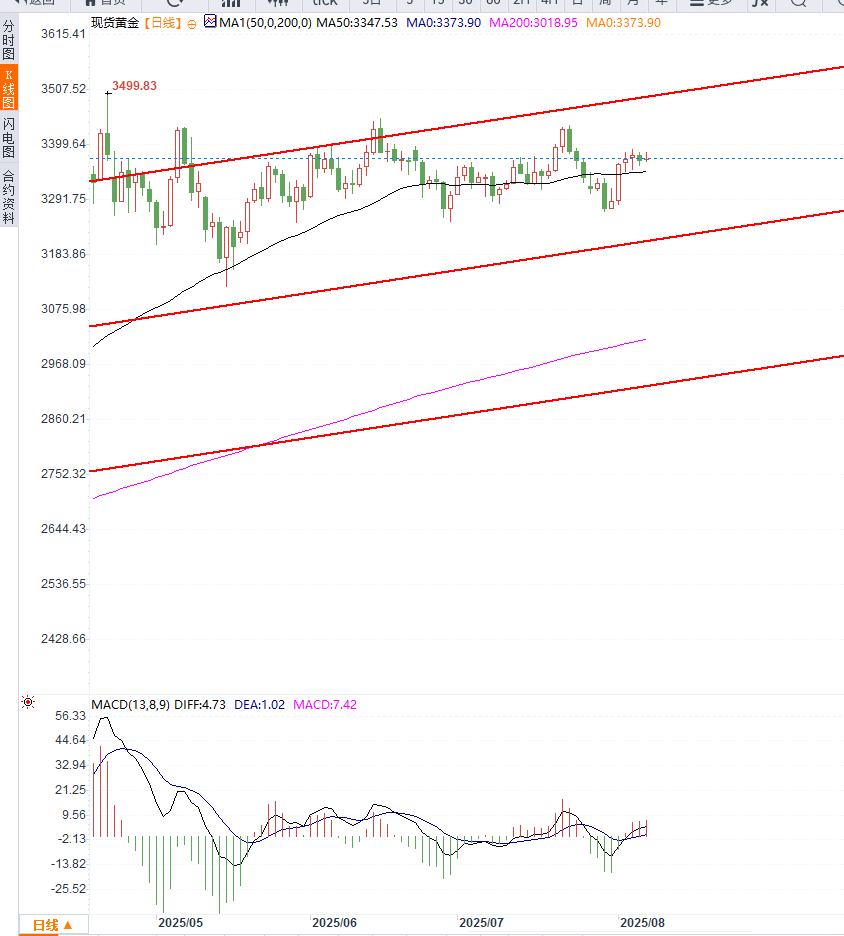Global trade concerns drive risk aversion, gold is expected to test the $3,400 mark
2025-08-07 13:59:59
The core event triggering this round of risk aversion was a new round of tariffs by the United States against major global economies. On Wednesday, US President Trump signed an executive order imposing an additional 25% tariff on all Indian goods, bringing the total tariff to 50%, citing India's continued imports of Russian crude oil.
In addition, media reports said that Trump may impose a new 15% tariff on Japanese goods and plans to implement a new round of tariff measures on goods from Asian countries in the semiconductor and pharmaceutical sectors.

"This type of multilateral tariff pressure is causing market concerns about global trade to rise again." - According to market research.
At the same time, market expectations that the Federal Reserve will launch a new round of interest rate cuts in September are rapidly increasing. The US non-farm payroll data released last Friday was lower than expected, and the weak ISM services PMI released on Tuesday has prompted investors to increase their bets on interest rate cuts this year.
According to the CME FedWatch tool, the market currently expects the probability of the Federal Reserve cutting interest rates by 25 basis points in September to be over 90%, and believes that there may be at least two more rate cuts this year.
"For gold, a shift towards easing interest rate expectations is equivalent to reducing the opportunity cost of holding interest-free assets, thus providing support." - According to market research.
However, the dollar rebounded modestly after hitting a one-week low, and Wall Street stocks rose overnight, limiting the upside of gold prices. The current market risk sentiment remains relatively positive and has not completely turned to a risk-averse pattern, which also explains why the rebound of gold is limited.
Gold prices are consolidating above $3,380, with short-term bulls attempting to break through the key resistance level of $3,400. The daily chart shows that prices have repeatedly tested the $3,380-3,385 range, indicating strong resistance there. The diverging MACD and RSI indicators indicate a deepening divergence between bulls and bears in the market.
The 4-hour chart shows even more positive signs: gold prices rebounded from the 200-period moving average this week. A break above $3,400 would confirm the continuation of the short-term uptrend, with targets targeting the $3,420-3,422 range. Strong resistance lies near the previous high of $3,434-3,435. A break above this level could push the price towards the all-time high of $3,500.
On the downside, $3,350 constitutes a short-term defense line. If it falls below, it will test the $3,315 line. Further support is seen at the $3,300 round mark. If it fails, it will trigger more technical selling pressure and even retrace to the monthly low of $3,268.

Editor's opinion:
Gold prices are currently driven significantly by macroeconomic policies and geopolitical events. In particular, the Trump administration's intertwined energy and tariff policies are continuously enhancing gold's appeal as a safe-haven asset. However, the impact of the US dollar and overall market risk appetite cannot be ignored.
The key technical level of $3,400 is becoming the focus of the tug-of-war between bulls and bears. Whether it breaks through will determine whether gold can regain its historical high of $3,500. Focus will be on the upcoming release of US initial jobless claims and speeches by Federal Reserve officials.
- Risk Warning and Disclaimer
- The market involves risk, and trading may not be suitable for all investors. This article is for reference only and does not constitute personal investment advice, nor does it take into account certain users’ specific investment objectives, financial situation, or other needs. Any investment decisions made based on this information are at your own risk.





















